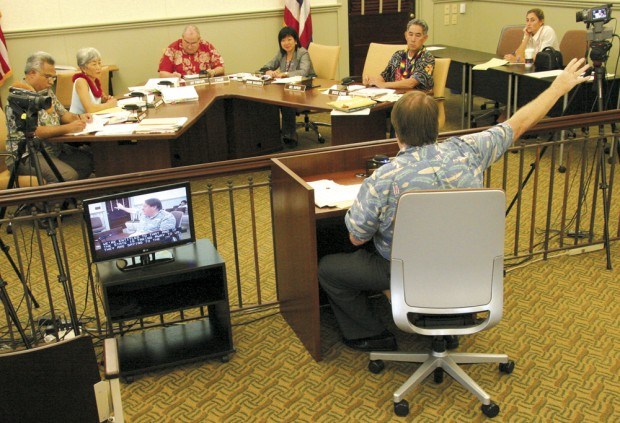LIHU‘E — A handful of bills recently introduced by the Kaua‘i County Council may jolt the county’s main revenue generator — real property taxes. While real estate market values continue to drop, council members and county officials are deciding what
LIHU‘E — A handful of bills recently introduced by the Kaua‘i County Council may jolt the county’s main revenue generator — real property taxes.
While real estate market values continue to drop, council members and county officials are deciding what is good and what is fair for Kaua‘i’s property owners, who may see some relief — even if just a little — in the next fiscal year.
0n July 9, 2008, then-Councilman Ron Kouchi introduced a comprehensive tax-reform bill by request of the administration of the late Mayor Bryan Baptiste.
Baptiste’s administration had proposed a 35 percent reduction on homestead taxes by increasing the homeowners’ exemption to at least $300,000, and up to $350,000 depending on age group. But the proposal, Bill 2274, was indefinitely deferred by the council.
Current homeowners’ exemptions begin at $48,000 ($96,000 for seniors ages 60 to 69, and $120,000 for seniors ages 70 and up). The council, however, recently approved an $80,000 exemption to all age groups on top of that. Last week the council’s Finance Committee extended that additional exemption to $120,000, which will face full council today for final approval.
Councilman Tim Bynum recently introduced Bill 2408 — also increasing homeowners’ exemption. He called it is a “milder” version of Baptiste’s proposal. But the bill was deferred pending further analysis and legal review. Bynum said keeping the bill dormant rather than killing it gives him a mechanism to reintroduce a restructured bill in the future.
Bill 2408 would increase the homeowners’ exemption to $225,000. Seniors ages 60 to 69 would receive a $250,000 exemption, and seniors over 70 years old would receive a $275,000 exemption.
County officials disagreed with Bynum on numbers and in the applicability of the bill.
Steve Hunt, from the county Finance Department, said it could take months for the county’s software vendor to figure out how to implement changes and calculations in the program. Bynum said he doesn’t think the county is lying, but he added he does not accept that answer “in this day and age.”
Shifting revenue sources
Bynum’s main concern is that in the last three years, with the real estate market values dropping, the county lost millions of dollars in tax revenues, while property taxes for residents who live and work on the island increased.
Single-family residential, apartment, commercial, agriculture, conservation and hotel and resort properties saw their taxes drop nearly $24 million collectively in the last three years, as the real estate market bubble deflated.
But a 2 percent cap supposed to protect and give predictability to the homestead class (owner-occupied homes with no additional dwellings) caused their taxes to increase $3.1 million in the last three years. Industrial-zoned land was the only other tax class that had an increase ($487,107) in the same period.
County officials say they believe tax reform is needed, and a couple of proposals — Bills 2416 and 2417 — have marched through several meetings. Bill 2416, which gave the additional $80,000 exemption, has already been approved. Bill 2417, which increased the exemption, will be up for full council discussion today.
Bill 2416, among many changes, also moved the notice of assessment to Feb. 15 from March 15, decreased taxpayer exposure to rollback taxes from six to three years and adjusted the 2 percent flat cap to a cap based on Honolulu’s Consumer Price Index for All Urban Consumers — up 2.5 percent over the past six months and 3.5 percent from a year ago, according to the U.S. Department of Labor, Bureau of Labor Statistics.
Bill 2417 would also tax property owners according to use rather than zoning, according to county Deputy Finance Director Sally Motta. Residents living on commercially zoned properties would see their taxes drop considerably, she said.
Cap: Friend or foe?
Bynum said he believes the 2 percent cap helped at first, but also created unfairness along the years. When the real estate market bubble was at its peak, homeowners who bought property at that time got capped at much higher rates than next door neighbors who got capped in 2004.
Motta had a different view of fairness. In 2003 (before the cap was implemented) homesteaders paid 12 percent of the county’s property taxes. When the market peaked in 2008, homesteaders, thanks to the 2 percent cap, paid 8 percent of the county’s property taxes. In 2011, with the market declining, homesteaders contribute to 11 percent of the county’s property taxes.
Comparatively, hotels and resorts paid 22 percent of the county’s property taxes in 2003, 19 percent in 2008 and 19 percent in 2011. Single-family residential paid 22 percent in 2003, 24 percent in 2008 and 23 percent in 2011. Apartment owners paid 14 percent in 2003, 17 percent in 2008 and 17 percent in 2009.
Other classes, commercial, conservation, agricultural and industrial, kept the same percentage or had a 1 to 2 percent variance in those years.


